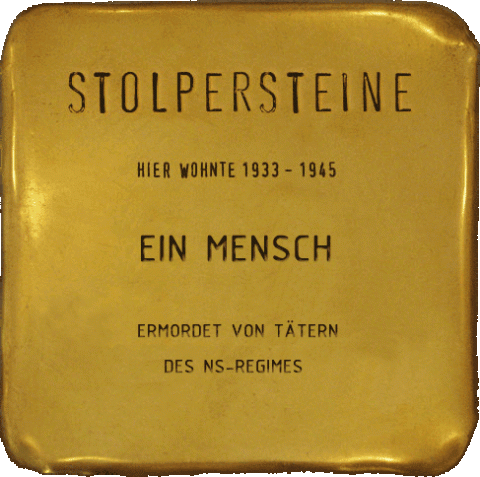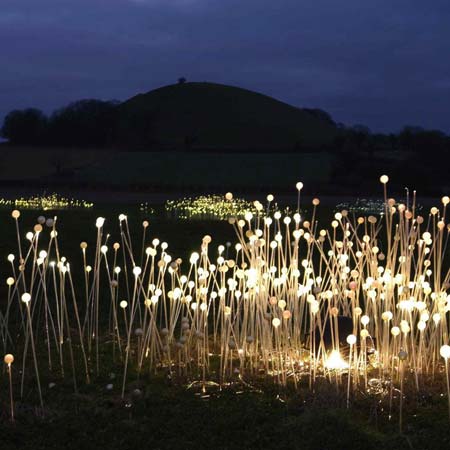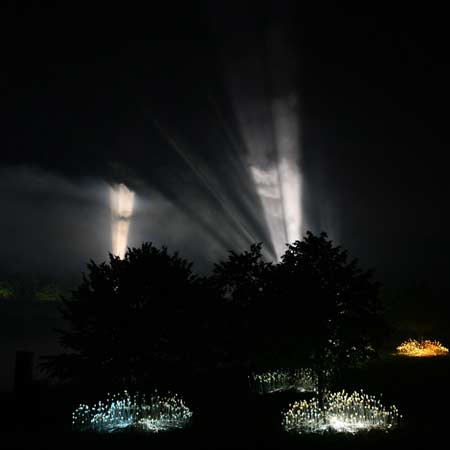Field of light
March 8, 2009
There are so many really nice light sculptures/art installations out already, but Lighting designer Bruce Munro shows that there are never enough. And that they keep getting even more beautiful.
Munro´s famous Field of Light (an apppropriate name) will be shown at the Eden Project in Cornwall, England, this winter. It was inspired by the way the desert flowers after a rainstorm.
“Munro was transfixed by the way the red desert was barren until it rained and then, as if from nowhere, dormant seeds would burst into bloom. He made a series of sketches in the notebook carried in his pocket since art college days, and the idea refused to dislodge from his mind.
Field of Light, like a giant surreal camp-side banana, is an alien installation in the midst of nature. And like dry desert seeds lying in wait for the rain, the sculpture’s fibre optic stems lie dormant until darkness falls, and then under a blazing blanket of stars they flower with gentle rhythms of light. ‘Field of Light’ is about the desert as much as the roadside campsites – and like much of Munro’s work is characterised by an almost mystical passion for nature teamed with a robust sense of humour.”
via Dezeen.
The House of falling furniture
December 22, 2008

“Since 1997, the building known locally as “The House of Falling Furniture” located at the corner of 6th st. and Howard st. in San Francisco, has been a sculptural mural.The piece consists of sometimes malshapened tables, chairs, lamps and even a grandfather clock, all hanging precariously out of the building’s windows. Officially named, ‘Defenestration’ (a word meaning to throw out of a window) the sculpture’s various pieces are all fastened to the abandoned building to create the illusion of falling. The pieces is the brainchild of local Bay Area artist, Brian Goggin.”I wanted to get art out of the gallery and out of the museum,” said Goggin. “I’m interested in working with absurdity in ways that are compelling and entertaining.”


“The site is part of a neighborhood that historically has faced economic challenge and has often endured the stigma of skid row status. Reflecting the harsh experience of many members of the community, the furniture is also of the streets, cast-off and unappreciated. The simple, unpretentious beauty and humanity of these downtrodden objects is reawakened through the action of the piece. The act of “throwing out” becomes an uplifting gesture of release, inviting reflection on the spirit of the people we live with, the objects we encounter, and the places in which we live.”
(I took the quotes directly from the artists websitethis time.)
VTOL
November 23, 2008

VTOL means Vertical Take Off and Landing, an installation by designers Kram/Weisshaar, which was shown during the Vienna Design Week this ocotober outside the went Liechtenstein Museum.
Their organic concrete surface seems to float above the ground. Smart use of mirros combined with an using an innovative glass fibre-reinforced concrete called fibreC. A really beautiful sculpture.
Light by studio roso
October 30, 2008

Interdisciplinary Studio Roso from London shows off their artinstallation at the Clark Shoe headquarters in Sommerset, UK.
It is meant to illustrate beams of light as they reflect dust particles spawning off the idea that light can only be seen when it´s reflected by something.

A really nice piece i thought, i especially like how it they got their inspiration. Sometimes you really just need to really experience the world around you and then you can even be inspired by dust parts dancing in the light.
Suggestion box
August 9, 2008
Suggestion Box is a project of the New York City based public art collaborative, Illegal Art.

From their website:
Hey, would you like to make a suggestion?
With that simple question and an enormous white Suggestion Box, Illegal Art canvassed the five boroughs of New York City, collecting suggestions from passersby of every stripe—the young, the old, the filthy rich, the homeless, the mouthy, and the shy. Some people held the Suggestion Box prisoner while they wrote suggestion after suggestion. Others ignored The Box, but then came scrambling back with a sudden idea. With over 300 handwritten suggestions straight from the streets of NYC, Suggestion is by turns hilarious, cryptic, inflammatory, and heartwarming. It’s also a testament to the public’s innermost desire—whether it’s free beer, free day care, or free pumpkin pie every Thursday.
Here is a list of some of the submitted suggestions.
via Swissmiss.
Krijin de Koning
August 9, 2008
Really interesting work by Krijin de Koning, an artist from the Netherlands whose works “deal with the idea of architecture and place”. Well, isn´t that what they all claim? But he does it really well i think. His – often temporary – installations cleverly change perception of the surroundings.
The featured work was shown 2006 in the Abbaye de Corbigny in France (yellow) and in Hilversum in the Netherlands in 1999 (blue).
Check out his website for more of his work.
Giant fried eggs
July 14, 2008
Sometimes i wonder why people create so many pieces which can only be seen from 40 000 feet above the ground, like the palmtrees in Dubai or the much talked about (but still a rumour) tulip off the coast of the netherlands.
But sometimes i don´t care 🙂
(sorry, i have no idea who the artist is or where the installation was..)
Stolpersteine – stumbling blocks
July 8, 2008

“Here lived from 1933-1945 a human being, killed by the perpetrators of the NS regime.”
Our cities overflow with so many monuments… of old kings (that no one knows anymore), generals or Holocaust memorials. Often you don´t really see them anymore and just walk past them (the exception being the amazing Holocaust memorial in Berlin). Memorials should make you feel and remember and empathize. Most stone memorials don´t really do that.
The “Stolpersteine by Gunter Demnig do. They can be found throughout germany and even Austria and Hungary, over 12500 of them. I “found” the first ones in our town Dortmund a few months ago. They remind us of people killed by the nazis, whether they were jews, homosexuals, members of the resitance or disabled people. A brass plaque is put in the ground in front of the houses where the people lived and says just “here lived” or like in Dortmund “here worked”, the name, year of birth and the fate of the person.
It´s so smart – and touching. The stones don´t match the allignment of the surrounding stones, you literally stumble over them. Even in the busi shopping street in Dortmund they stand out, not like a monument where you just walk around…they “hit” you personally and make you stop and look.
The New York City Waterfalls Project
May 11, 2008
The New York City Waterfalls Project is from (one of) my favourite artist(s), Olafur Elisasson and will be seen in NY from late June to Mid-October 2008.

The Berlin and Copenhagen based artist wants the people to notice and recognize the water that´s surrounding NYC again, because “we tend to see [the water] as a simple surface, framed by a neutral urban waterfront. I wish to amplify its physical and tangible presence while exposing the dynamics of natural forces such as gravity, wind and daylight.”
…
“With The New York City Waterfalls, i want to focus on the waterfall as a spectacle, operating on a grand and impressive scale, while also offering an intimate and intellectually challenging experience to the people visiting the sites along the waterfront.”
I think it is a very smart (and of course breathtakingly beautiful) way to make people aware of the great natural force of the water around NYC again. It´s absolutly true, that the attention is more diverted to the skyline, and the structures of the city itself. To find something so majestic right in front of you, and then recognizing that it was there the whole time and you just didn´t notice it, will be a real powerful experience for inhabitants and visitors of the city.
Just reading about it changed my perception of the waterfront already. But i really really want to see it in person, too.
Mended spiderwebs
May 4, 2008
US artist Nina Katchadourian used needle, red thread and glue to mend spiderwebs she found around her house in Pörtö, Finnland. The spiders however rejected her help:
“The morning after the first patch job, I discovered a pile of red threads lying on the ground below the web. At first I assumed the wind had blown them out; on closer inspection it became clear that the spider had repaired the web to perfect condition using its own methods, throwing the threads out in the process. My repairs were always rejected by the spider and discarded, usually during the course of the night, even in webs which looked abandoned.”
The mended webs are really beautiful, but i like even more that nature, or in this case the owners of the web, the spiders, had the last word and showed her how its done properly 🙂
The threads and the reaction of the spiders reminded me what amazing constructions spiderwebs are in general, too.







